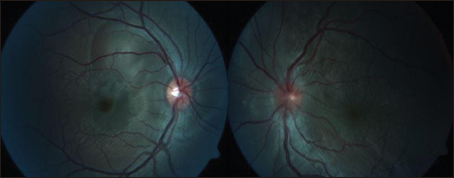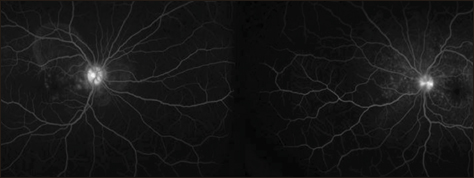Young woman presents with blurred vision, loss of visual fields
Both eyes had large areas of subretinal fluid and choroidal thickening.
A 19-year-old Hispanic woman with no significant medical or ocular history was referred to the department of ophthalmology at the Lahey Clinic for evaluation of recent acute vision loss.
Her history was notable for 1 month of persistent, severe left-sided headache that did not improve with pain medications. One week before presentation, she developed blurred vision in her left eye with loss of central and nasal visual fields and severe pain with extraocular movements. On the day of presentation, she noted ringing in her left ear. She had no significant family history of eye disease. She had no history of blood transfusions and did not smoke, drink alcohol or use illicit drugs. Complete ocular and systemic review of symptoms was negative except as noted above. A CT scan of the head obtained before presentation was unremarkable.
Examination
Upon examination, the patient’s visual acuity was 20/40 in the right eye and 20/100 in the left eye. The left pupil had a sluggish response to light and an afferent pupillary defect. IOP was 18 mm Hg bilaterally. Confrontational visual fields revealed temporal hemifield loss in the left eye, while the right eye had full confrontational fields. Extraocular movements were full bilaterally. Color vision was decreased bilaterally.

Images: Dajani OAW, Soukiasian S

Anterior segment exam was significant for 2+ anterior chamber cell in the right eye, without any cell in the left anterior chamber. Bilaterally, anterior vitreous exam revealed significant haze. Fundus exam demonstrated bilateral large areas of subretinal fluid including the subfoveal region with mottling. The left eye had more significant fluid on exam with diffuse serous retinal detachments throughout the periphery (Figure 1) as well as engorged venules. The right optic nerve was hyperemic while the left appeared pink and sharp. OCT revealed bilateral diffuse subretinal fluid and choroidal thickening (Figure 2).
What is your diagnosis?
See answer on next page.
Uveitis with serous retinal detachments
Our patient was found to have bilateral uveitis with serous retinal detachments. Differential diagnosis of acute onset serous retinal detachments in the setting of uveitis includes a host of inflammatory and infectious etiologies such as Vogt-Koyanagi-Harada disease, posterior scleritis, sarcoidosis, tuberculosis and syphilis plus masquerade syndromes of leukemia, lymphoma and carcinoma.
Lab workup included a CBC, ACE, lysozyme, CRP, QuantiFERON Gold, Treponema pallidum antibody, Lyme C6 peptide and a chest X-ray. CRP was elevated to 16.6 mg/L. All other labs were normal. Chest X-ray revealed borderline enlarged heart without hilar adenopathy. Fluorescein angiography demonstrated pinpoint hyperfluorescence throughout the macula bilaterally (Figure 3). The patient was diagnosed with Vogt-Koyanagi-Harada (VKH) syndrome based on her ocular findings in the setting of headache and tinnitus. The patient had no history of ocular trauma or surgery, precluding a diagnosis of sympathetic ophthalmia, which can have an identical presentation in the eye.

Discussion
VKH is an inflammatory systemic disease affecting pigmented tissues of the ocular, auditory and central nervous systems due to an autoimmune process directed against melanin. In the eye, VKH presents as a bilateral, granulomatous panuveitis. Extraocular symptoms classically include a constellation of tinnitus, headache/meningismus and vitiligo. Like many autoimmune diseases, VKH predominantly affects women between 20 and 50 years with a predisposition for Asian, Middle Eastern and Hispanic patients.
Classically, VKH presents in four stages, each with distinct features. The prodromal stage can last up to 5 days and resembles a viral illness in which patients may complain of headaches, fever, nausea and other nonspecific systemic symptoms. Tinnitus is also a common feature at this stage. Ocular symptoms during the prodromal phase include blurred vision and photophobia, but ocular findings are minimal. During the second stage, the uveitic stage, acute ocular findings peak. Patients may have anterior chamber cell, granulomatous keratic precipitates, peripheral anterior or posterior synechiae, and scleritis. Posterior exam will reveal bilateral serous retinal detachments with thickening of the choroid. Vitritis and optic disc edema are often present. The third stage, or the chronic/convalescent stage, occurs weeks after the uveitic stage. It is at this stage that the classic dermatologic manifestations of alopecia, poliosis and vitiligo develop. The posterior exam will begin to show signs of depigmentation leading to a “sunset glow” fundus due to loss of pigment at the level of the retinal pigment epithelium and choroid, a finding most often seen in Asian patients. Lastly, during the recurrent stage, patients may experience a relapse of anterior uveitis as well as cataracts, glaucoma and possible subretinal neovascularization. Recurrent posterior uveitis is uncommon.
Diagnostically, VKH is associated with five clinical criteria that dictate whether the disease is classified as complete, incomplete or probable. The diagnostic criteria include no history of ocular trauma; no evidence of other ocular disease processes; bilateral ocular involvement; presence of neurologic or auditory findings; and dermatologic findings. Complete VKH is diagnosed when all five preceding criteria are met. Incomplete VKH is defined as meeting criteria one through three plus either neurologic, auditory or dermatologic findings. Probable VKH includes only criteria one through three.
When VKH is suspected, workup must be initiated to rule out other similar-appearing disorders. A good initial approach includes a complete blood count, syphilis serology, ACE, lysozyme and TB testing. In addition, blood pressure should be measured because acute hypertension can cause bilateral serous retinal detachments. A chest X-ray should be included to help rule out sarcoidosis and possible TB. B-scan ultrasound is used to identify posterior scleritis, and a CT or MRI of the brain is a critical step in ruling out another central nervous system disorder if neurologic symptoms are present. In terms of ocular imaging, an OCT will typically show subretinal fluid and a thickened choroid bilaterally. Fluorescein angiography demonstrates pinpoint areas of hyperfluorescence at the level of the retinal pigment epithelium.
Standard management includes the use of systemic corticosteroids daily for a minimum of 6 months with a slow taper after the first 2 to 4 weeks. Patients are followed weekly at first, then monthly with monitoring for recurrent inflammation. Prognosis depends on time from onset of symptoms to initiation of treatment, as well as the number of recurrences.
Clinical course continued
The patient was started on 70 mg of oral prednisone and seen 1 week after initial presentation. Overall visual acuity continued to decline to 20/200 in the right eye during the first week, but the left vision improved to 20/60. OCT demonstrated continued serous retinal detachments bilaterally but with improvement in the level of fluid in the left eye. Both headaches and tinnitus resolved. The patient is now undergoing a slow prednisone taper from 70 mg to 40 mg over 3 weeks, when further steroid course will be determined after follow-up examination.
- References:
- Bordaberry MF. Curr Opin Ophthalmol. 2010;doi:10.1097/ICU.0b013e32833eb78c.
- Rao NA. Int Ophthalmol. 2007;doi:10.1007/s10792-006-9029-2.
- Read RW, et al. Am J Ophthalmol. 2001;doi:10.1016/S0002-9394(01)00925-4.
- Read RW, et al. Am J Ophthalmol. 2001;doi:10.1016/S0002-9394(01)00937-0.
- Rubsamen PE, et al. Arch Ophthalmol. 1991;doi:10.1001/archopht.1991.01080050096037.
- Yanoff M, et al. Ophthalmology. 3rd ed. Mosby Elsevier; 2008.
- For more information:
- Omar A.W. Dajani, MD, and Sarkis Soukiasian, MD, can be reached at New England Eye Center, Tufts University School of Medicine, 750 Washington St., Box 450, Boston, MA 02111; website: www.neec.com.
- Edited by Aubrey R. Tirpack, MD, and Astrid C. Werner, MD. They can be reached at the New England Eye Center, Tufts University School of Medicine, 750 Washington St., Box 450, Boston, MA 02111; website: www.neec.com.
